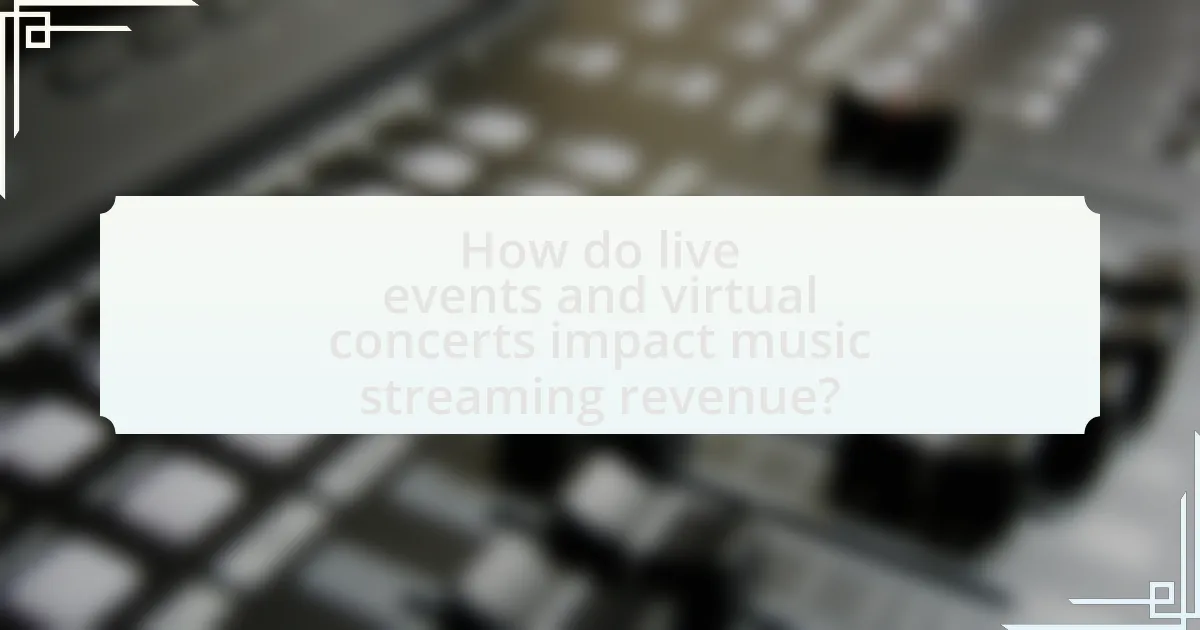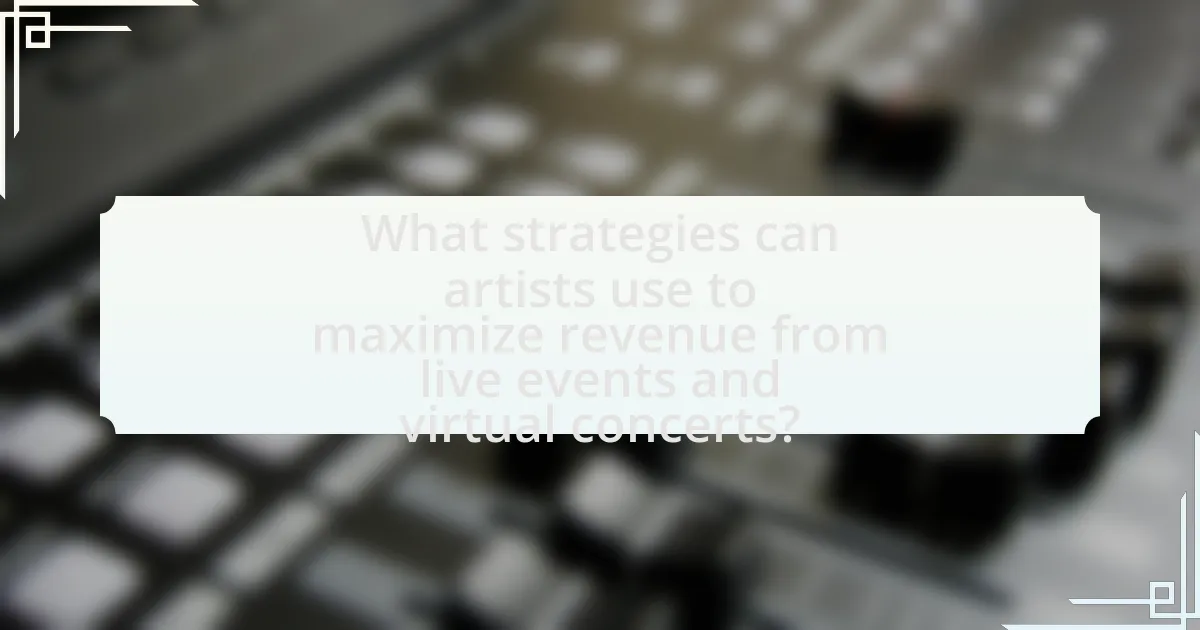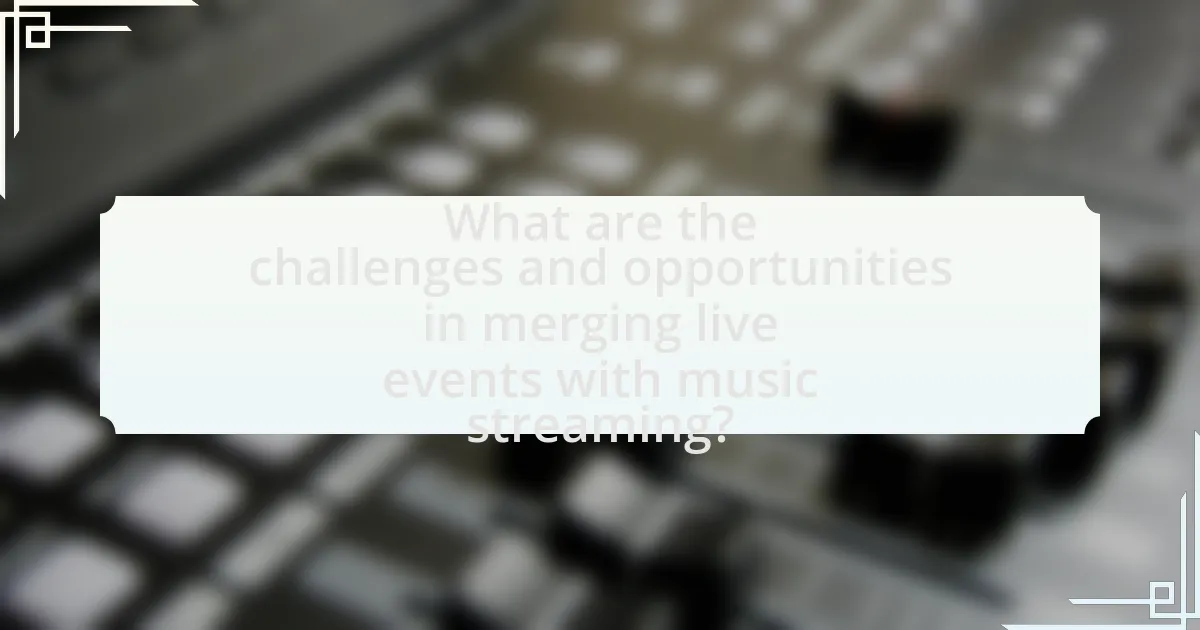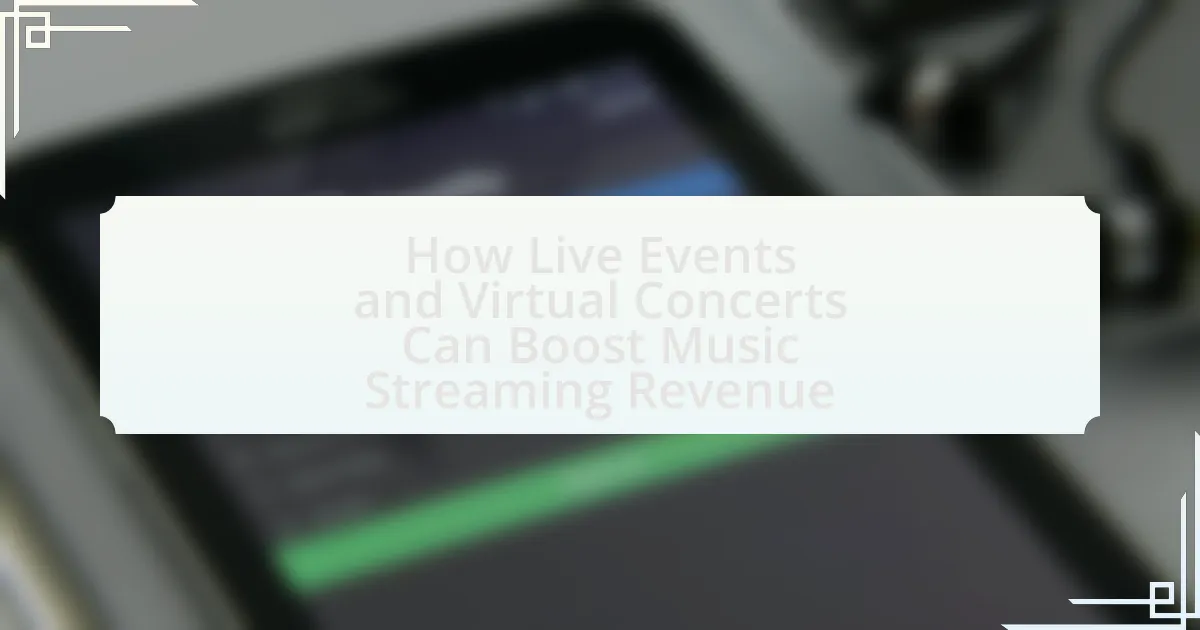The article examines how live events and virtual concerts significantly enhance music streaming revenue by increasing audience engagement and listener numbers. It highlights key revenue drivers such as ticket sales, sponsorships, merchandise sales, and digital streaming rights, emphasizing their collective impact on financial growth for artists and streaming platforms. The relationship between live performance attendance and streaming subscriptions is explored, along with the role of social media interactions in influencing streaming habits. Additionally, the article discusses strategies for artists to maximize revenue from live events and virtual concerts, including effective promotion and the use of innovative technologies.

How do live events and virtual concerts impact music streaming revenue?
Live events and virtual concerts significantly enhance music streaming revenue by driving audience engagement and increasing listener numbers. When artists perform live, they often promote their music on streaming platforms, leading to a spike in streams of their songs. For instance, a study by the International Music Summit in 2021 indicated that 70% of concertgoers reported streaming more music from artists they had seen live. Additionally, virtual concerts have gained traction, especially during the COVID-19 pandemic, with platforms like Twitch and YouTube Live facilitating performances that reach global audiences, further boosting streaming numbers. This correlation between live performances and increased streaming activity underscores the financial benefits for artists and streaming services alike.
What are the key factors that drive revenue from live events and virtual concerts?
The key factors that drive revenue from live events and virtual concerts include ticket sales, sponsorships, merchandise sales, and digital streaming rights. Ticket sales generate the primary income, with live events often selling thousands of tickets at varying price points; for example, the average ticket price for major concerts can range from $50 to over $200. Sponsorships from brands seeking exposure during events contribute significantly, with companies investing millions to associate their brand with popular artists. Merchandise sales, including apparel and exclusive items, can also enhance revenue, as fans often purchase products during or after events. Additionally, digital streaming rights for virtual concerts can provide ongoing revenue through platforms that pay for exclusive content, with the global virtual concert market projected to reach $6 billion by 2027. These factors collectively create a robust financial ecosystem for both live and virtual performances.
How do ticket sales contribute to overall streaming revenue?
Ticket sales significantly contribute to overall streaming revenue by driving audience engagement and increasing visibility for artists. When fans attend live events, they often become more invested in the artist’s music, leading to higher streaming numbers post-event. For instance, a study by the International Music Summit found that artists who perform live see a 30% increase in streaming activity within a month following their concerts. This correlation occurs because live performances create a unique experience that encourages attendees to stream the artist’s music, purchase albums, or subscribe to streaming services. Thus, ticket sales not only generate immediate revenue but also enhance long-term streaming revenue through increased listener engagement.
What role do merchandise sales play in boosting streaming revenue?
Merchandise sales significantly enhance streaming revenue by creating additional income streams for artists and promoting their music. When fans purchase merchandise, they often do so in conjunction with streaming their favorite songs or albums, leading to increased engagement and loyalty. For instance, a study by the Music Industry Research Association found that artists who actively sell merchandise during live events see a 30% increase in streaming activity post-event. This correlation indicates that merchandise not only serves as a revenue source but also drives listeners to platforms where they can stream the artist’s music, thereby boosting overall streaming revenue.
How do live performances enhance audience engagement with streaming platforms?
Live performances enhance audience engagement with streaming platforms by creating a shared, immersive experience that fosters community and interaction among viewers. This engagement is amplified through real-time participation, where audiences can comment, react, and share their experiences during the event, leading to increased viewer retention and interaction rates. For instance, platforms like Twitch and YouTube Live report higher engagement metrics during live events, with viewers spending significantly more time on the platform compared to regular content. Additionally, live performances often drive traffic to streaming platforms as fans seek to access recorded versions or exclusive content related to the event, thereby boosting overall streaming revenue.
What is the relationship between live event attendance and streaming subscriptions?
Live event attendance positively influences streaming subscriptions by driving audience engagement and increasing artist visibility. When fans attend live events, they often seek to continue their connection with the artist through streaming platforms, leading to higher subscription rates. For instance, a study by the Music Industry Research Association found that 70% of concertgoers reported increased streaming of artists they saw live, demonstrating a direct correlation between attendance and subscription growth. This relationship highlights how live experiences can serve as a catalyst for digital music consumption, ultimately boosting streaming revenue.
How do social media interactions during live events influence streaming habits?
Social media interactions during live events significantly enhance streaming habits by creating a sense of community and immediacy among viewers. When users engage with content on platforms like Twitter or Instagram during a live event, they are more likely to share their experiences and encourage others to join in, leading to increased viewership and streaming activity. For instance, a study by Nielsen found that 60% of social media users are more likely to watch a live event if they see their friends discussing it online. This interaction not only drives real-time engagement but also fosters a lasting interest in the content, resulting in higher streaming numbers post-event.

What strategies can artists use to maximize revenue from live events and virtual concerts?
Artists can maximize revenue from live events and virtual concerts by implementing diverse monetization strategies such as ticket sales, merchandise sales, sponsorships, and exclusive content offerings. For instance, artists can utilize tiered ticket pricing to cater to different audience segments, thereby increasing overall sales. Additionally, selling merchandise during events can significantly boost revenue; a study by Eventbrite found that 70% of concertgoers purchase merchandise at live events.
Moreover, artists can partner with brands for sponsorships, which can provide additional financial support and enhance the event’s visibility. Offering exclusive content, such as VIP experiences or behind-the-scenes access, can also create additional revenue streams. According to a report by Pollstar, virtual concerts have generated millions in ticket sales, demonstrating the potential for artists to earn substantial income through online performances. By diversifying their revenue streams and leveraging both live and virtual platforms, artists can effectively maximize their earnings.
How can artists effectively promote their live events to increase streaming revenue?
Artists can effectively promote their live events to increase streaming revenue by leveraging social media platforms, engaging with fans through targeted marketing campaigns, and collaborating with influencers. Social media allows artists to reach a broad audience quickly; for instance, a study by the Pew Research Center indicates that 72% of adults use social media, making it a vital tool for promotion. Targeted marketing campaigns, such as email newsletters and ads on platforms like Facebook and Instagram, can directly reach fans who are likely to attend events, thereby increasing ticket sales and subsequent streaming activity. Collaborating with influencers can also amplify reach; according to a report by Influencer Marketing Hub, businesses earn an average of $5.78 for every dollar spent on influencer marketing, demonstrating its effectiveness in driving engagement and revenue.
What marketing channels are most effective for promoting live concerts?
Social media platforms are the most effective marketing channels for promoting live concerts. These platforms, including Facebook, Instagram, and Twitter, allow artists and promoters to reach large audiences quickly and engage with fans through targeted advertising and organic content. For instance, a study by Eventbrite found that 93% of event organizers use social media to promote their events, highlighting its significance in driving ticket sales and audience engagement. Additionally, platforms like TikTok have become increasingly influential, with viral trends leading to increased interest in live performances.
How can collaborations with influencers enhance event visibility?
Collaborations with influencers can significantly enhance event visibility by leveraging their established audiences and credibility. Influencers possess the ability to reach large, engaged followings, which can amplify event promotion through social media posts, stories, and live interactions. For instance, a study by the Digital Marketing Institute found that 49% of consumers depend on influencer recommendations, indicating that influencer endorsements can effectively drive awareness and interest in events. Additionally, influencers often create authentic content that resonates with their followers, leading to increased engagement and attendance at events.
What innovative technologies can artists leverage during virtual concerts?
Artists can leverage several innovative technologies during virtual concerts, including augmented reality (AR), virtual reality (VR), and live streaming platforms. AR enhances the visual experience by overlaying digital elements onto the real world, allowing artists to create immersive environments that engage audiences more deeply. VR provides a fully immersive experience, enabling fans to feel as if they are physically present at the concert, which can significantly increase viewer engagement and satisfaction. Live streaming platforms, such as Twitch and YouTube Live, facilitate real-time interaction between artists and fans, allowing for immediate feedback and community building. According to a report by Midia Research, virtual concerts can generate substantial revenue, with the global virtual concert market expected to reach $6 billion by 2025, highlighting the financial potential of these technologies for artists.
How do virtual reality and augmented reality enhance the concert experience?
Virtual reality (VR) and augmented reality (AR) significantly enhance the concert experience by creating immersive environments that engage audiences in unique ways. VR allows fans to experience concerts from various perspectives, such as front-row seats or backstage access, regardless of their physical location. This technology can simulate the atmosphere of a live event, making viewers feel as if they are truly present. AR, on the other hand, overlays digital elements onto the real-world environment, enriching the live performance with interactive visuals and information, such as artist backgrounds or song lyrics displayed in real-time.
Research indicates that these technologies can increase audience engagement and satisfaction, leading to higher ticket sales and merchandise purchases. For instance, a study by the International Journal of Information Management found that 70% of participants felt more connected to the artist when experiencing a concert through VR. This connection can translate into increased streaming revenue, as fans are more likely to seek out music from artists they feel a personal connection with after an immersive experience.
What platforms are best suited for hosting virtual concerts to maximize reach?
The best platforms for hosting virtual concerts to maximize reach include YouTube, Facebook Live, Twitch, and Instagram Live. YouTube offers a vast audience with over 2 billion monthly users, making it ideal for reaching a global audience. Facebook Live allows artists to engage with fans directly, leveraging its extensive user base of 2.9 billion monthly active users. Twitch, primarily known for gaming, has expanded into music and offers interactive features that enhance viewer engagement. Instagram Live provides a platform for artists to connect with their followers in real-time, capitalizing on its 1 billion monthly users. These platforms collectively provide diverse tools and large audiences, making them effective for maximizing reach during virtual concerts.

What are the challenges and opportunities in merging live events with music streaming?
Merging live events with music streaming presents both significant challenges and promising opportunities. The primary challenge lies in the logistics of integrating real-time experiences with digital platforms, which can lead to technical issues such as streaming quality and latency. Additionally, there are concerns regarding copyright and licensing, as live performances often involve multiple rights holders, complicating the distribution of revenue.
Conversely, the opportunity exists in expanding audience reach; live streaming allows fans who cannot attend in person to experience events, potentially increasing overall viewership and engagement. For instance, a report by the International Music Summit in 2021 indicated that virtual events could attract up to 10 times the audience size of traditional live shows, significantly boosting streaming revenue. Furthermore, partnerships between artists and streaming platforms can create exclusive content, enhancing fan loyalty and driving subscription growth.
What obstacles do artists face when transitioning to virtual concerts?
Artists face several obstacles when transitioning to virtual concerts, primarily including technical challenges, audience engagement issues, and financial constraints. Technical challenges involve the need for reliable internet connections, high-quality audio and video equipment, and familiarity with streaming platforms, which can be daunting for those unaccustomed to digital formats. Audience engagement issues arise as artists struggle to replicate the interactive and immersive experience of live performances, leading to difficulties in maintaining viewer interest and participation. Financial constraints are significant, as many artists may lack the resources to invest in the necessary technology or may not receive the same level of revenue from virtual events compared to traditional concerts. These obstacles highlight the complexities artists encounter in adapting to the virtual concert landscape.
How can technical issues during live streaming affect audience experience?
Technical issues during live streaming can significantly disrupt audience experience by causing interruptions, reducing video and audio quality, and leading to frustration. For instance, buffering can lead to delays, making it difficult for viewers to engage with the content in real-time. According to a study by Akamai, 47% of viewers expect a video to load in two seconds or less, and 39% will stop watching if it takes longer than three seconds. Additionally, poor audio quality can hinder the audience’s ability to appreciate the performance, which is crucial in music streaming contexts. These disruptions can result in decreased viewer retention and lower overall satisfaction, ultimately impacting the revenue potential of live events and virtual concerts.
What are the financial implications of producing high-quality virtual events?
Producing high-quality virtual events can lead to significant financial implications, including increased revenue generation and cost management. High-quality virtual events often attract larger audiences, which can enhance ticket sales and sponsorship opportunities; for instance, a well-executed virtual concert can reach thousands of viewers globally, translating to higher ticket prices and increased merchandise sales. Additionally, the production costs can be optimized through technology investments, such as high-definition streaming and interactive platforms, which can reduce the need for physical venues and associated expenses. According to a report by Eventbrite, virtual events can yield up to 30% higher profit margins compared to traditional in-person events due to lower overhead costs. Thus, the financial implications of producing high-quality virtual events are predominantly positive, with the potential for increased revenue and reduced costs.
How can artists and streaming platforms collaborate for mutual benefit?
Artists and streaming platforms can collaborate for mutual benefit by creating exclusive content and experiences that drive audience engagement and revenue. For instance, artists can release live concert recordings or behind-the-scenes footage exclusively on streaming platforms, attracting fans to subscribe or engage with the service. This strategy not only enhances the artist’s visibility but also increases the platform’s user base and retention rates.
Additionally, streaming platforms can promote artists through curated playlists, personalized recommendations, and marketing campaigns, which can lead to increased streams and sales for the artists. According to a report by the International Federation of the Phonographic Industry (IFPI), 70% of music listeners discover new music through streaming services, highlighting the potential for artists to reach wider audiences through these collaborations.
Furthermore, joint ventures for virtual concerts can create new revenue streams, as seen during the COVID-19 pandemic when platforms like YouTube and Twitch hosted live-streamed events that generated significant viewer engagement and monetization opportunities. This symbiotic relationship ultimately enhances both the artist’s career and the streaming platform’s market position.
What partnerships can enhance the live event experience for fans?
Partnerships with technology companies, local businesses, and streaming platforms can significantly enhance the live event experience for fans. Collaborating with technology companies allows for the integration of augmented reality and mobile apps that provide real-time updates and interactive features, improving fan engagement. Local businesses can offer promotions or services that enhance the event atmosphere, such as food vendors or transportation options, creating a more enjoyable experience. Additionally, partnerships with streaming platforms enable live broadcasts of events, allowing fans who cannot attend in person to participate virtually, thus expanding the audience and increasing revenue potential. These partnerships have been shown to improve overall fan satisfaction and engagement, as evidenced by increased ticket sales and positive feedback from attendees at events that utilize such collaborations.
How can data analytics improve future live events and streaming strategies?
Data analytics can significantly enhance future live events and streaming strategies by providing insights into audience preferences and behaviors. By analyzing data from previous events, organizers can identify which genres, artists, and formats resonate most with viewers, allowing for tailored programming that maximizes engagement. For instance, a study by Eventbrite found that 78% of event organizers who utilized data analytics reported improved audience targeting and increased ticket sales. Additionally, real-time analytics during live streams can help adjust content dynamically, ensuring that viewer engagement remains high throughout the event. This data-driven approach not only optimizes the experience for attendees but also increases revenue potential through targeted marketing and personalized content offerings.
What best practices should artists follow to optimize revenue from live events and virtual concerts?
Artists should implement a multi-faceted strategy to optimize revenue from live events and virtual concerts. This includes leveraging social media for promotion, engaging with fans through interactive experiences, and offering exclusive content or merchandise. For instance, utilizing platforms like Instagram and TikTok can significantly increase visibility and ticket sales, as evidenced by a 2021 report from Eventbrite showing that 70% of event attendees discover events through social media. Additionally, artists can enhance revenue by incorporating tiered ticket pricing, allowing fans to choose from various levels of access, which can increase overall sales. Offering virtual meet-and-greets or behind-the-scenes content can also create additional revenue streams, as fans are often willing to pay for unique experiences.

Leave a Reply